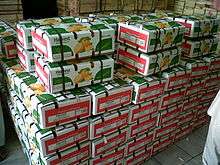Kinnow
The 'Kinnow' is a high yield mandarin hybrid cultivated extensively in the wider Punjab region of India and Pakistan.
| Kinnow | |
|---|---|
 Kinnow, Courtesy by SMHT | |
| Hybrid parentage | 'King' (Citrus nobilis) × 'Willow Leaf' (Citrus × deliciosa) |
| Breeder | Howard B. Frost, University of California Citrus Experiment Station in 1935 |
It is a hybrid of two citrus cultivars — 'King' (Citrus nobilis) × 'Willow Leaf' (Citrus × deliciosa) — first developed by Howard B. Frost,[1] at the University of California Citrus Experiment Station. After evaluation, the 'Kinnow' was released as a new citrus hybrid for commercial cultivation in 1935.[2]
Description
In a hot climate, plants can grow up to 35 feet high.[3] 'Kinnow' trees are highly productive; it is not uncommon to find 1000 fruits per tree.
The fruit matures in January or February. It peels easily and has a high juice content.
Seedless kinnow/ low seeded kinnow
The high seed content in this variety is a major hindrance in out-of-hand eating. Mikeal Roose[4] of University of California, Riverside, USA developed low seeded 'Kinnow' and this variety was released under the name 'Kinnow LS' in the year 2011. H.S.Rattanpal[5] of Punjab Agricultural University, Ludhiana, India developed low seeded 'Kinnow' through mutation breeding and recommended it under the name 'PAU Kinnow-1' in the year 2015. In Pakistan, a seedless 'Kinnow' has been developed (using selection method) by Niaz Ahmad Chaudhry '', a team member of National Agricultural Research Centre (NARC), Islamabad 'NARC' (former director of Citrus Research Institute, Sargodha,'CRI'.
Export from Asia
Most of the target export markets of Indian and Pakistani 'Kinnow' are those of developing countries. Only 2.6 percent of Kinnow exports target the markets of developed countries, which is due to the emerging demand for seedless Kinnow by the developed countries. About 61 percent of total world exports of oranges and mandarins are of seedless varieties. Some important export markets for 'Kinnow' are:Iran, Bahrain, United Arab Emirates, Kuwait, Oman, Qatar, Saudi Arabia, Indonesia, Malaysia, Afghanistan, Netherlands, Philippines, Singapore, the United Kingdom, Russia and Vietnam.[6] Indonesia has also offered market access to Kinnow, from Pakistan at zero per cent.[7] Over 40% of the Pakistani exports of Kinnows went to Russia in 2015.[8] Internally, the prices of Kinnow in Pakistan dropped more than 50% between 2016 to 2020.[9]
Harvesting and handling
The 'Kinnow' fruit seeds are planted in the month of August-October. 'Kinnow' harvesting starts when the fruit's external colour becomes orange, from December to February. The best harvesting time is mid-January to mid-February, when the fruit attains a TSS/acid ratio of 12:1 to 14:1. The fruit quality declines in later pickings. Fruits are harvested by clipping the stem with the help of sharp clippers (secateurs). The stem is cut as short as possible to avoid mechanical injury to the fruit in packing and transits. As it is a comparatively loose rind fruit, harvesting by pulling fruits with one's hands is avoided. Coating 'Kinnow' fruits with commercial waxes can increase the shelf life up to 60 days. The fruit can be stored in cold storage at a temperature of 4-5 °C and a relative humidity of 85-90%.[10]

Fruit processing
Food processing includes the selection of good-quality fruit. The ideal 'Kinnow' is firm to slightly soft, smooth-skinned with no deep grooves, and deep orange to almost red. Human hands can better judge and avoid product with soft spots, dull and faded coloring or rough and bumpy skin. Many processing technologies have been developed by state agricultural universities and other research institutes of India. Kinnow fruits can be stored at room temperature conditions or under cold storage conditions.[10]
Notes
- Y. H. Hui, M. Pilar Cano, and Josef Barta (Editors) Handbook of Fruits and Fruit Processing. Wiley, John & Sons. 2006. ISBN 978-0-8138-1981-5; page 312.
- "Kinnow". ucr.edu.
- "newitworld.com". newitworld.com. Archived from the original on 2015-02-04.
- "UCR Newsroom: UC Riverside releases new citrus variety: 'KinnowLS'". newsroom.ucr.edu. Retrieved 2017-05-19.
- "Cross pollination: PAU low seeded kinnow scores over Pak variety". The Indian Express. 2015-04-02. Retrieved 2017-05-19.
- Marketing of Fruits Under WTO Regime, Dr. M. Sharif and Burhan Ahmad, Social Sciences Institute, NARC Islamabad Archived 2008-12-11 at the Wayback Machine
- "Indonesia, Pakistan ink trade agreement". Investvine.com. 2013-02-17. Retrieved 2013-02-21.
- "Kinnow demand: Over 40% of exports go to Russian market". The Express Tribune.
- "Retail Prices of Kinnow in Pakistan from 2015-2020". Deliver It - Online Sabzi Mandi / Grocery Store in Islamabad.
- "Citrus cultivation in Punjab" (PDF). Punjab Agricultural University, Ludhiana, India.
External links

- Carrier has recently conducted a study to show how cold chain can help reduce wastage and reduce carbon footprint when kinnow is preconditioned and transported with Reefer trucks. For detailed report see: http://naturalleader.com/wp-content/uploads/2017/01/Kinnow-report_Read.pdf